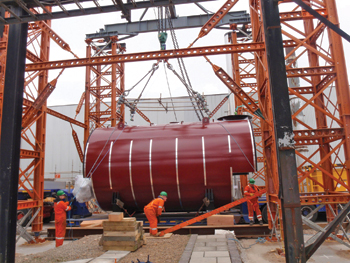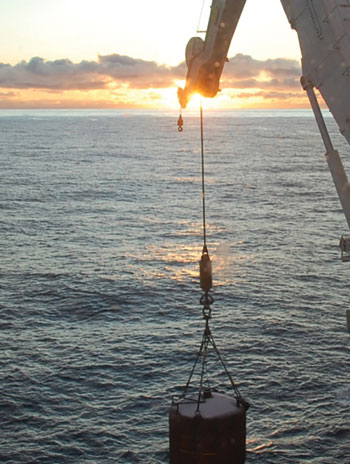
 A revival of heavy engineering projects can fuel demand
A revival of heavy engineering projects can fuel demand
GLOBAL shipping lines that carry breakbulk and heavy-lift cargo had to navigate choppy waters in 2014, not for lack of cargo, but for rates that were too low for them to make a profit.
Breakbulk and project cargo freight rates have been depressed for the last two years, and so many carriers are losing money that industry analysts expect some smaller carriers to face bankruptcy in 2015 or consolidation with other carriers, at the very least.
“The bigger multipurpose carriers are financially secure, but the smaller carriers are going to be in trouble (in 2015) if the rates don’t start to move,” says Susan Oatway, a senior consultant at London-based Drewry Shipping Consultants. “There should be consolidation, the way the markets and the rates are. The smaller carriers are more likely to do that before they go under.”
The low rates aren’t being caused by overcapacity of the multipurpose fleet, which is Oatway called “right-sized.” The problem is that multipurpose carriers face stiff competition from the dry bulk and container sectors, which are suffering from overcapacity and are cutting rates to fill their ships with containerized breakbulk cargo such as lumber and plywood. Even heavy-lift project cargo carriers are seeing some of their cargo cannibalised by container lines that load heavy cargoes on racks that take up as many as nine slots on a container ship.
“We continue to be concerned about competition from container lines, particularly for the project carriers. Any delay in the recovery of that sector will also delay recovery in this one,” Oatway says.
If container freight rates and demand improve in 2015, container lines will become more reluctant to carry this difficult and time-consuming cargo. “Some of it is coming back into the breakbulk and project cargo market, enough so that we are cautiously optimistic for 2015,” Oatway says.
Meanwhile, breakbulk and project cargo rates remain depressed. “We lose on every ton we carry,” Rickmers Holdings chairman Bertram Rickmers told the Breakbulk Americas Conference in Houston in October. “If we as an industry continue like this, some of the carriers will be out of business.” He called on the industry to help lift rates, saying, “Rates must go up soon.”
According to German ship banks, 40 to 50 per cent of project-carrying vessels of 8,000 to 30,000 deadweight tonnes are in severe financial difficulties. “Uncountable ones are in fact controlled by mortgage banks and just left under the management of its present owners,” Rickmers says. “How long do these banks watch their so-called shipowners not paying interest, not paying installments and not being able to run the ships in a proper way?” he asks.
Their shaky finances are not being caused by a dearth of demand. “There’s cargo out there that the EPC (engineering, project and construction) shippers are moving,” Oatway says. “Demand is improving enough to push the rates back up the hill.”
EPC cargo, in fact, is a booming business, fueled by the estimated $100 billion in petrochemical and refining projects in the US Gulf that are being planned to process growing volumes of oil and gas extracted by fracking. “The US is going through a resurgence of plant construction that’s all associated with shale gas,” says Dennis Devlin, vice president of sales south and head of business development energy solutions for Panalpina US.
 |
The project cargo business is quite healthy |
Many of the components for these projects are no longer built in the US and must be imported as project cargo from China, South Korea, India, Turkey and Europe. Devlin says there’s no lack of heavy-lift vessel capacity for importing these project cargoes, but he’s feeling the pinch from the shortage of flatbed trucks. “The trucking side is a concern because it’s all part of the project supply chain,” he says.
The Port of Houston is seeing steady growth in imports of tubular steel for oil and gas pipelines being built to carry oil and gas to the plants and projects being built around the port. Steel imports in 2014 were on pace to reach or surpass the record volume of 5.9 million tonnes achieved in 2008 before the Great Recession, according to Stan Swigart, the port’s trade development manager.
A Greater Houston Port Bureau economic study projects that the region can expect more than $35 billion in plant expansions in the next three to five years. When these projects come to fruition, the port expects to see a huge expansion in its containerized petrochemicals exports, especially resins.
Meanwhile, the port is upgrading City Dock 32 in the turning basin to handle the growth of breakbulk and heavy-lift cargo imports it expects for these projects. It has installed a 600-ton crawler crane to handle heavy loads on its own three-acre pad next to a rail spur and is expanding and reinforcing the yard by 18 acres. Heavy engineering companies such as Bechtel are bringing in components for these projects, mainly from China and some from Europe.
On top of this, the wind power sector continues to import wind blades and turbines for wind farms from northern Europe through Gulf ports. “We’ve got wind blades stacking up in our yard,” Swigart says. He expects wind power imports to continue as long as the current tax incentives remain in effect.
Other regions also are seeing a revival of heavy engineering projects that are fueling demand. “I see the project cargo business as quite healthy,” Devlin said. “We are booking a lot of project cargo on the ocean.” Industrial Info Projects, a market intelligence service, has identified 80,722 chemical projects in various stages of planning and development around the globe that are worth an estimated $13.2 trillion.
“There are pockets of interesting projects in a couple of regions that suggest that there is enough happening that rates will start to pick up, all of which leads me to be cautiously optimistic about 2015, but I don’t think rates will pick up much before 2016,” Oatway says.
After a lull in heavy engineering projects in the Middle East, Saudi Arabia and the UAE have resumed work on projects that will generate imports of project cargo. Saudi Arabia is pouring money into industrial projects unrelated to petroleum. It also is building an airport at Jeddah and the so-called Saudi landbridge project to build a $7 billion railway from Jeddah to Riyadh that eventually will connect the Red Sea with the Persian Gulf. The existing 280-mile line between Riyadh and Dammam will be upgraded, and a second 72-mile line is planned to connect Dammam with Jubail on the Persian Gulf. The newly constructed lines will be single track, but the infrastructure —including bridges and tunnels — will be designed to permit a future upgrade to dual track.
Abu Dhabi has numerous infrastructure projects under development for Expo 2020. Qatar has several transportation projects and is beginning to build a new stadium for the 2022 FIFA World Cup.
The question remains as to whether the pickup in global projects will accelerate rapidly enough to lift project cargo rates. It’s difficult to get a handle on the finances of multipurpose carriers because most of them are privately owned and don’t disclose earnings. “The rates can’t go any lower or the smaller carriers can’t survive.” Oatway says.
But not all is doom and gloom for these carriers, because outside ship finance investment may ride to the rescue. “We have seen outside money coming in for refinancing,” Oatway says. “There’s more interest in the stock market for carriers trying to raise money through initial public offerings, so I think the owners are more likely to do that before they go under.”




































































